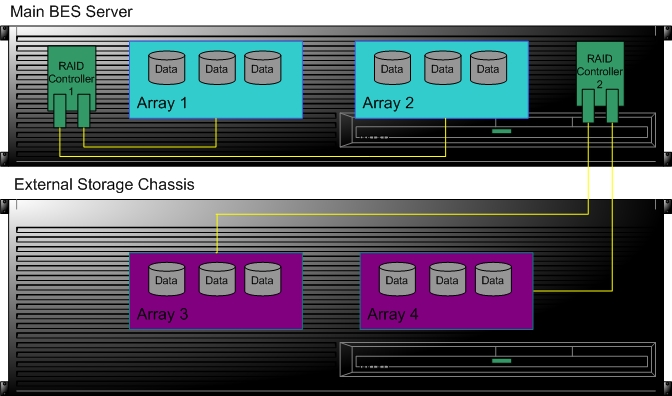
Recommended BigFix Array Configurations
| Expected Performance | RAID Controllers | RAID Array 1 (internal) | RAID Array 2 (internal) | RAID Array 3 (external) | RAID Array 4 (external) |
| OK | Single RAID controller with two array slots | RAID 5 (3+ Disks) OS, BigFix Application, SQL Server Application |
RAID 10 (8+ Disks) Database, Transaction Logs |
n/a | n/a |
| Better | Two RAID controllers | RAID 5 (3+ Disks) OS, BigFix Application, SQL Server Application |
n/a | RAID 10 (8+ Disks) Database, Transaction Logs |
n/a |
| High | Two RAID controllers with two array slots | RAID 5 (3+ Disks) OS, BigFix Application, SQL Server Application |
n/a | RAID 10 (4-8+ Disks) Database |
RAID 10 (4-8+ Disks) Transaction Logs |
| Optimal High | Two RAID controllers with two array slots | RAID 5 (3+ Disks) or RAID1 (2 Disks) OS |
RAID 10 (4+ Disks) BigFix Application, SQL Server Application |
RAID 10 (8+ Disks) Database |
RAID 10 (8+ Disks) Transaction Logs |
RAID Information Pertaining to BigFix
- The only types of RAID it makes sense for use with BigFix are: RAID 1, RAID 5 and RAID 10. The only reason you would use RAID 1 is because you don't have enough disks or you are using it for the OS array. The only reason to use RAID 5 over RAID 10 is because you don't have enough disks.
- RAID 1 - Disk Mirroring
- Minimum Number of Drives: 2
- Strengths: Very high performance, very high data protection, very minimal penalty on write performance.
- Weaknesses: High redundancy cost overhead, all data duplicated means you get half the storage available in disks.
- RAID 5 - Block-level data striping with distributed parity
- Minimum Number of Drives: 3
- Strengths: Best cost/performance for transaction-oriented networks; very high performance, very high data protection, supports multiple simultaneous reads and writes.
- Weaknesses: Write performance is slower than RAID 0 or RAID 1.
- RAID 10 - Combination of RAID 0 (data striping) and RAID 1 (mirroring)
- Minimum Number of Drives: 4
- Strength: Highest performance, highest data protection (can tolerate multiple drive failures).
- Weaknesses: High redundancy cost overhead, duplicated data halves available storage, requires at least 4 drives.
Guidelines
- Smaller/faster disks are best. BigFix doesn't use a lot of disk space so we are better of maximizing disk speeds and throughput over volume.
- SAS/SATA Drives and Raid Controllers are better then SCSI.
- Prefer 2.5in drives at 10K or 15K RPM over 3.5 in drives at 15K RPM. Smaller form factor reduces seek times.
- RAID 10 provides best performance (read/write throughput and seek times). We would expect 8+ in each array (16+ total) in the high end servers.
- RAID 5 typically used on OS for fault tolerance and good performance.
- RAID 5 occasionally used instead of RAID 10 on SQL arrays but we prefer RAID 10 because it is faster. Notice that RAID 5 is slow on writing so it would not be good to use with a database array that is heavy on writing.
- You can partition the RAID arrays into logical partitions which are smaller to maximize seek times. That is, if your array of small fast disks provides 120 GB but your database on the array only uses about 20 GB you could separate the array into 2 logical partitions of 60 GB (or 80/40) each and not use the second partition. This forces the database to use only half of the platter and maximizes seek times (disk heads don't ever need to track to the unused partition).
- Separating the transaction logs helps maximize the database throughput since each SQL transaction requires a write to the transaction logs, then a write to the database for the transaction itself and finally a commit to the transaction logs.
- Typically RAID cache ratios are set to 50/50 read/write. In some cases it may make sense to try something more granular like 25/75 read/write for a database which is doing a lot of writing but not much reading (i.e. a large deployment with very few BigFix Console operators).
